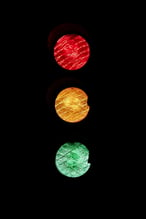
Know someone that's color blind? Or, have you ever found yourself wondering whether or not dogs see the world in black and white?
There's a lot of talking about color blindness, but also, we've found, a lot of confusion. What does it mean? Why does it occur? We spoke with one of our independent optometrists to shed light on the subject, and now we're breaking down the medical reason for color blindness, as well as varying degrees and factors that are at play when it comes to seeing (or not) color.
3 Points About Color Blindness You Probably Didn't Know
1. Color blind, defined: Colorblindness occurs when a person has defective cones inside of their eyes. Cones, what?
Without getting too science-y on you, the back of the eye (called the retina), is made up of cones and rods. Rods are found in the periphery of your eye. They see more black and white and also serve as motion detectors. Rods function better in the dark than cones, which live in the central part of your retina, do. Cones pick up color and are your eye's detail sensors.
If a person is color blind, that means that some or all of their cones are defective or damaged. If all cones are impaired, the result is total color blindness: you can't detect any color, and instead essentially see the world through black and white. If only some of your cones are negatively affected, you will consequently be either red-green color blind or blue-yellow color blind.
2. Red-green color blindness: It is what it sounds like - people who suffer from this
variation of color blindness  are unable to distinguish between the go-to
are unable to distinguish between the go-to
Christmas colors - red and green. Depending on which cones are damaged, a person can be more affected by red colors, while others green. If you are less sensitive to red light, you'll likely not only mix up red and green, but also blue
and green. On the other hand, if you are less sensitive to green light, in addition
to the red/green confusion, you'll also have trouble differentiating gray and purple.
3. Blue-yellow color blindness: This one's a bit misleading because people do not mix
up blue and yellow. They will, however, confuse blue with green, and yellow with violet. Blue-yellow is the rarest form of color blindnesses and usually the least debilitating in everyday life.

There you have it!
So before you go making fun of a friend for being unable to properly match their outfit, now you can think twice before tossing around the term color blind. And if you're still wondering about your dog, here's your answer.
Want to make sure your eyes are in good health, but struggling to find time to get to the eye doctor? No problem, read our case study about how on-site eye exams are an engaging, valuable employee benefit. Then, give us a call!



